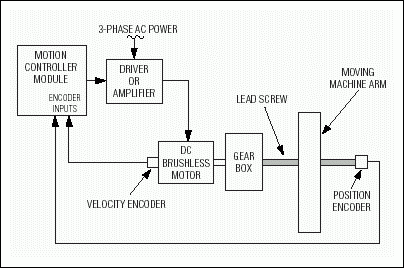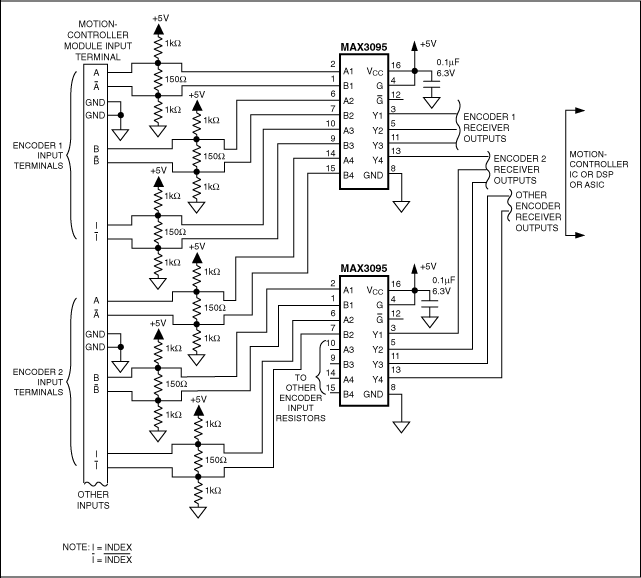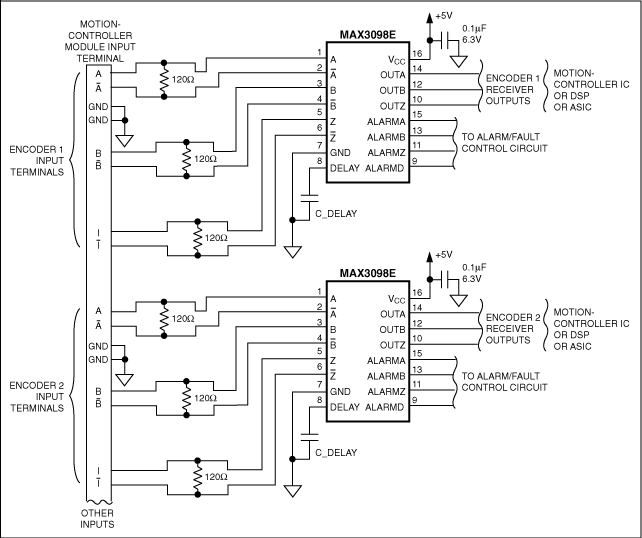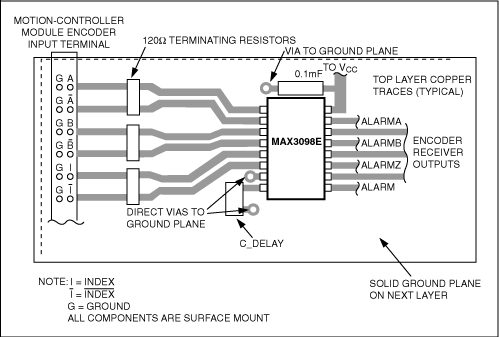设计坚固、容错的运动控制反馈系统
The key to robust operation in a system lies in the way it handles mechanical and electrical faults. This article discusses the design of a robust and fault-tolerant motion-control system whose feedback paths incorporate quadrature encoders.
Servo Systems
Modern automated systems incorporate closed-loop feedback for motion control. They typically include a servo system that consists of a motor driver and feedback elements combined in a manner that gives accurate and stable control over speed and position. The various system-level components of a typical servo system are illustrated in Figure 1.

Figure 1. This DC brushless servo system uses quadrature optical encoders to provide velocity and position feedback to the motion controller.
详情介绍
The key to robust operation in a system lies in the way it handles mechanical and electrical faults. This article discusses the design of a robust and fault-tolerant motion-control system whose feedback paths incorporate quadrature encoders.
Servo Systems
Modern automated systems incorporate closed-loop feedback for motion control. They typically include a servo system that consists of a motor driver and feedback elements combined in a manner that gives accurate and stable control over speed and position. The various system-level components of a typical servo system are illustrated in Figure 1.

Figure 1. This DC brushless servo system uses quadrature optical encoders to provide velocity and position feedback to the motion controller.
DC brushless motors are preferred for high-performance and high-speed applications. DC brush and stepper motors are suitable for low-speed and less-demanding applications. Brushless motors are assumed throughout this article. Such motors typically include a quadrature encoder on the end shaft that determines the shaft velocity and commutation point for controlling the motor's coil-switching sequences (see sidebar, Feedback encoder types). A second quadrature encoder on the machine's rotating shaft provides position data for that shaft, which generally differs from the motor-shaft position due to inaccuracies caused by backlash in the gearhead and lead-screw assemblies.
Typical motion-controller cards and modules include a motion-control IC, a microprocessor, and a DSP or custom ASIC for processing the high-speed encoder signals. The controller provides velocity and direction-of-rotation signals to the driver or amplifier, which in turn provides the proper levels of voltage and current (power) to operate the motor. To design a robust and fault-tolerant motion-control system with feedback, you must address the following items at the system level during design:
- Controller-encoder input circuits (receiver circuits)
- Receiver circuit PC-board layout
- Encoder-signal cabling system
Though not addressed in this article, motion-controller inputs, such as hard-wired emergency stop and limit inputs, should also be considered when designing a faulttolerant feedback system.
Controller Receiver Circuits
The motor's quadrature encoder sends six RS-422/RS-485 signals (A, A\, B, B\, Index, and Index\) down the cable to the motion controller's receiver circuit (the encoder input). The receiver converts the RS-422 signals to logic-level signals (we assume RS-422 signals because the system has only one transmitter), and feeds them to the motion-controller circuit for processing. (For RS-422 and RS-485 differences, refer to the short online tutorial RS-485 Basics at www.maximintegrated.com.) The receiver circuit must respond to various faults in the servo-system environment, including opens, shorts, and noise. See the sidebar Fault types for information on faults and ESD.
Figure 2 illustrates the encoder-input receiver circuit in a typical motion controller. U1 is a 10Mbps, 5V, quad RS-422/RS-485 receiver with ±15kV ESD protection. For fault-tolerant systems with encoder inputs that connect to external components, ESD protection is a must. The absence of external ESD-protection components substantially reduces the PC-board area required for this circuit.

Figure 2. Part of a motion controller, this encoder-input receiver circuit features open-line detection and ESD protection (internal to the MAX3095) on all encoder input lines.
The 150Ω resistors provide proper terminations for each group of complementary signal pairs transmitted down the twisted-pair cable from the quadrature encoder. (Cable termination and related issues are covered in detail later.) A break or disconnect in the cable produces an open-circuit fault that must be detected before the motion controller can take appropriate action. As a fail-safe measure, the MAX3095 receiver outputs assert a logic high in response to an open-circuited input pair. The 1kΩ resistors bias the receiver's "A" inputs at least 200mV above its "B" inputs. They are also necessary for maintaining fail-safe outputs in the presence of the input-termination resistors. This circuit provides ESD protection, open-circuit detection, and output short-circuit protection, but does not detect short-circuited inputs. An improved circuit (Figure 3) includes two ICs, each of which includes three RS-422/RS-485 receivers. Each receiver provides built-in fault detection, ±15kV ESD protection, and a 32Mbps data rate. The MAX3098E detects open- and short-circuited encoder inputs. It also detects low-voltage differential signals, common-mode range violations, and other faults. Its logic-level outputs indicate which receiver input has the fault condition. By reporting the fault directly, that feature reduces software overhead and minimizes the need for external logic components.

Figure 3. This circuit improves that of Figure 2 with detection of open, shorted, and intermediate faults, ESD protection on all encoder input lines, and delayed alarm/fault outputs.
A fault on any encoder input produces an immediate logic high on the corresponding output: ALARMA, ALARMB, or ALARMZ. Slow movement of the servo system can produce transient faults at the quadrature-encoder signal's zero-crossing region, thereby triggering a "false fault." You can delay the ALARMD output (logic OR of ALARMA, ALARMB, and ALARMZ) for a desired interval by selecting the C_Delay value. The 120Ω resistors provide proper RS-422 terminations for the cable. Because the IC is available in a 16-pin QSOP package, this circuit requires fewer components and occupies a very compact space on the PC board.
Receiver Circuit PC-Board Layout
A proper layout of the receiver circuit starts with the RS-422 encoder's input connector. The differential signal pairs A A\, B B\, and Index Index\ must occupy adjacent pins on the connector. This configuration minimizes signal imbalance by ensuring that the differential pair's returning signal-current paths overlap and cancel. Typical component placements are shown in Figure 4. To ensure that each PC-board trace has the same parasitic capacitance, route each differential pair of traces close together, with equal lengths, and with symmetrical bends.

Figure 4. A MAX3098 triple RS-422/RS-485 receiver with fault detection ensures proper PC-board routing and component placement for the encoder inputs of a motion controller.
To minimize inductive and capacitive crosstalk on the digital outputs and provide lower inductance, differential RS-422 signals from the connector and the receiver circuit should be laid over a solid ground-plane layer within the PC board. No high-current signals should flow in this ground plane.
The high-speed current switching in motion controller circuits can produce common-mode noise. The use of filters and bypass capacitors helps to reduce the effect of common-mode voltages coupled onto the power supply lines. You should place a 0.1µF bypass capacitor close to the receiver's VCC input. To minimize inductance in the bypass loop, the capacitor's ground lead should connect directly to the solid ground plane, as should the IC ground pin through a via placed adjacent to it. Finally, to minimize noise coupling to the receiver circuits, routing receiver traces near to or adjacent to any power circuits should be avoided.
Encoder Signal Cable
Because the differential signals from a quadrature encoder are balanced, they can be transmitted on regular paired cable, but twisted-pair cable is preferred. Twisted-pair cables have very low-inductance coupling and constant impedance up to several megahertz, which enables exceptionally high-speed performance in motion-control systems. Twisted-pair cables also help to reduce radiated and received EMI.
Twisted-pair cable is available shielded or unshielded. Unshielded cable is smaller, costs less, weighs less, and is bendable in a smaller radius, but shielded twisted-pair cable must be used for the differential quadrature-encoder signals. Shielded twisted-pair cable provides better common-mode rejection, because the shield offers additional protection from electric and magnetic interference (EMI). The nonideal twists in an actual unshielded twisted-pair cable allow a dramatic increase in EMI noise. Connect the shield wire to the receiver's ground plane at the encoder-input connector.
The encoder's signal cable should not carry power-level signals or any other signals at all. Nor should it be routed close to or parallel to other cables or conduits that carry power-level signals or other noisy signals, including 60Hz power.
Modern, high-speed servo-control systems operate with encoders that provide data rates up to several megahertz. At such high rates, the encoder-signal cable must be properly terminated with a terminating resistor or network at the receiver end. Ideally, the terminating resistor has the same value as the cable's characteristic impedance.
Because only one transmitter (encoder output) is on the RS-422 network (one transmitter and one receiver), the transmitter does not require a terminating resistor. Ringing and reflections on a nonterminated receiver input, however, can restrict the data throughput to several hundred kilobits per second. Matching the characteristic impedance of a cable to within ±20% is usually more than adequate. Proper termination of encoder cables is illustrated in Figures 2 and 3.
Thus, modern high-speed servo systems can be designed for a robust and fault-tolerant motion-control feedback system. Receiver circuits for the motion controller must respond predictably to the various faults that can develop, and a proper PC layout for the receiver circuit prevents noise problems in the encoder data. A designer should also consider the quadrature encoder's signal-cabling system, including terminations at the receiver circuit. These precautions produce a robust motion-control feedback system that is stable and predictable during fault conditions.
Sidebar: Fault Types (FT)
Opens, shorts, and a condition intermediate between the two are the faults most obvious at the system level. Motors and feedback encoders are usually located tens to hundreds of feet from the servo-system controller/amplifier. Connectors terminate these long cable runs at both ends, and it is possible for wires to fall out of the connectors, for connectors to break, and for cables to be inadvertently opened. When end connectors break open or wires sever due to machine vibration, the open or short fault often exhibits several open/reconnect or short/open cycles similar to the contact bounce in a switch before opening up or shorting completely. Because feedback-encoder signals are usually transmitted down a twisted pair, the differential signals are likely to short together during a short fault.
Intermediate faults can develop when the resistance or capacitance of a feedback wire increases, as is possible when a poor installation pinches the cable. Such problems can also manifest during later operation. When moisture enters a damaged cable jacket, for example, the cable capacitance can increase over time, causing signal strength to decrease. That condition is common in heavy industrial environments, where automated equipment can require a daily wash-down. The cable remains operational even though its performance degrades over time. As a precaution, you should include a circuit for detecting moisture-contamination faults.
Noise faults can be the most difficult to eliminate, because noise can originate from electromagnetic interference (EMI), radio-frequency interference (RFI), and/or ground or system-level ground loops. System-level noise sources (radiators) include:
- Arcing of DC-motor brushes during commutation
- High-speed dv/dt switching noise from PWM motor amplifiers
- High-power relays, switches, and actuators such as solenoids
- Random turn-on of SCRs and TRIACs during the 60Hz AC cycle
- Switching power supplies
- Electrostatic discharge
Noise receivers (antennas) include long cables, ground connections, long high-impedance traces on PC boards, and transformers. Noise problems require a method of coupling between a receiver and a radiator, such as capacitive, inductive, or conductive coupling. Capacitive coupling typically occurs in high-impedance circuits when wires or other ungrounded pieces of metal pick up or generate electric fields. For a circuit to couple noise capacitively, the circuit's loop impedance must exceed the intrinsic impedance of air (376.7Ω).
Inductive coupling typically occurs with low-impedance circuits for which the circuit's loop impedance is less than 376.7Ω. Wires, open-core inductors, and transformers pick up or generate magnetic fields that can cause EMI noise. The current loops for these circuits must be minimized during design and installation.
Conductively coupled noise usually enters the circuit at ground. For DC noise, it takes the path of least DC resistance in the ground plane, and for AC-coupled noise, the least impedance. As a result, the circuit reference point (ground) tends to be at a voltage above or below its normal value, or (worst case) a dynamically changing value.
Ground loops formed between the AC-power neutral and system-level ground can generate random noise by causing ground current to flow. Ground current can be driven by voltage differences, induction from other cables or devices, wiring errors, ground faults, or the normal equipment leakage that occurs in an industrial environment.
Common-mode noise, defined as common to two nodes that are floating or exhibiting high impedance, can be AC or DC. Common-mode noise can be inherent in the system design, but is usually coupled inductively or capacitively from an external source. A 60Hz signal from the power line, for example, lying adjacent to a pair of signal wires from an analog sensor, can couple inductively onto the wires and drown out the low-level sensor signal.
Electrostatic discharge (ESD) develops when two dissimilar materials come together, transfer charge, and move apart, producing a voltage between them. IC pins that connect to external connectors are susceptible to ESD when a technician connects or disconnects those cables during maintenance.
ESD injected into the pins of an IC can cause the IC to latch up or fail completely. Very high currents can flow during latchup, causing the main power supply to current limit, or causing the system to enter an uncontrolled shutdown. IC pins exposed to external signals or connectors without internal ESD protection must incorporate ESD protection such as metal-oxide varistors, or silicon avalanche suppressors such as TransZorbs. ICs with built-in ESD protection save PC space, and thereby support the drive for smaller form factors and smaller industrial enclosures.
Sidebar: Feedback Encoder Types (FE)
To attain accurate positioning, a servo system requires a feedback signal to close its feedback loop. Instruments that typically provide the feedback signal include optical encoders, resolvers, and quadrature magnetostrictive linear-displacement transducers. Other instrument types for this purpose are not discussed in this article. They include analog tachometer generators, induction generators, Hall-effect pickups, and potentiomentric devices.
Optical encoders, which provide a digital square-wave feedback signal, include quadrature (incremental), absolute, and pseudorandom types. A typical optical encoder consists of the emitter side, the detector side, and a code wheel, which provides a raw analog signal to the encoder's processing circuitry. A comparator stage then converts the analog to a digital output. Digital formats include open-collector outputs and (for single-ended outputs) 5V to 24V logic. For noise immunity, the most robust outputs are the complementary, differential RS-422 types.
Quadrature optical encoders provide feedback signals in the form of A, B, and Z pulses. The A and B signals exhibit a phase separation of 90° from the encoder's code wheel and are, therefore, in quadrature (i.e., electrically spaced one-fourth of a period apart). When A goes positive prior to B, the encoder is rotating clockwise, and vice versa for counterclockwise rotation. Thus, position, direction, and velocity data can be derived from these two signals. The Z signal indicates the motor's rotor position, and whether the encoder shaft has rotated 360°. It also checks for miscounts of the A and B signals. For RS-422 connections, the encoder provides complementary signals for the A, B, and Z outputs.
Absolute optical encoders employ signal-processing components similar to those of the quadrature optical encoder, but their outputs provide one parallel binary word per increment of revolution. Typical outputs are twelve to thirteen bits of BCD, gray, or natural binary code, and the 13-bit outputs impose a lower frequency response (1200 RPM for 12 bits vs. 600 RPM for 13 bits) in exchange for the finer resolution per 360° of rotation. This encoder type is typically used for monitoring shaft position during power-up and power-down because, unlike quadrature encoders, the encoded output lets you read the shaft position without moving the encoder.
The new pseudorandom optical encoders provide three output signals: A and B provide direction sense and spatial timing, and a third provides position data. Pseudorandom optical encoders require 1° to 2° of rotation to determine position.
Resolvers are feedback encoders that provide sine and cosine output waveforms, which can be processed to provide velocity and position data through the servo controller. A resolver's feedback signals represent absolute position when its shaft is rotating, but low-speed performance is poor. The main disadvantage of a resolver is the relatively expensive resolver-to-digital electronics necessary for processing its signals.
Finally, quadrature magnetostrictive linear-displacement transducers (LDTs) are feedback encoder/transducers designed to measure linear motion, rather than the rotational motion measured by encoders above. The analog position signal is developed from a current pulse sent down a magnetostrictive guide wire, interacting with a position magnet that moves with a linear-displacement rod protruding from the LDT. The reflected pulse is sensed by a pickup sensor. The LDT then processes and digitizes the pickup sensor signal to provide quadrature-output signals A, B, and Z, similar to those of a quadrature encoder.
Glossary of Terms
Backlash: The mechanical play between two or more adjacent gears.
Index: On a quadrature encoder, the output signal that provides one pulse per revolution.
Latchup: Complete failure in an IC, or momentary loss of operation.
Resolution: The number of bits in an output signal, or (for quadrature encoders) the number of cycles per revolution.
Bibliography
- Barnes, John R., Electronic System Design, Interference And Noise Control Techniques, Englewood Cliffs, N.J., Prentice-Hall, 1987.
- Application Note 578: New RS-485 IC Increases System Reliability and Fault Detection in Motor-Control Circuits.
- Thomas, Sokira J. & Jaffe, Wolfgang, Brushless DC Motors, Electronic Commutation and Controls, Blue Ridge Summit, PA, TAB Books Inc., 1990.
